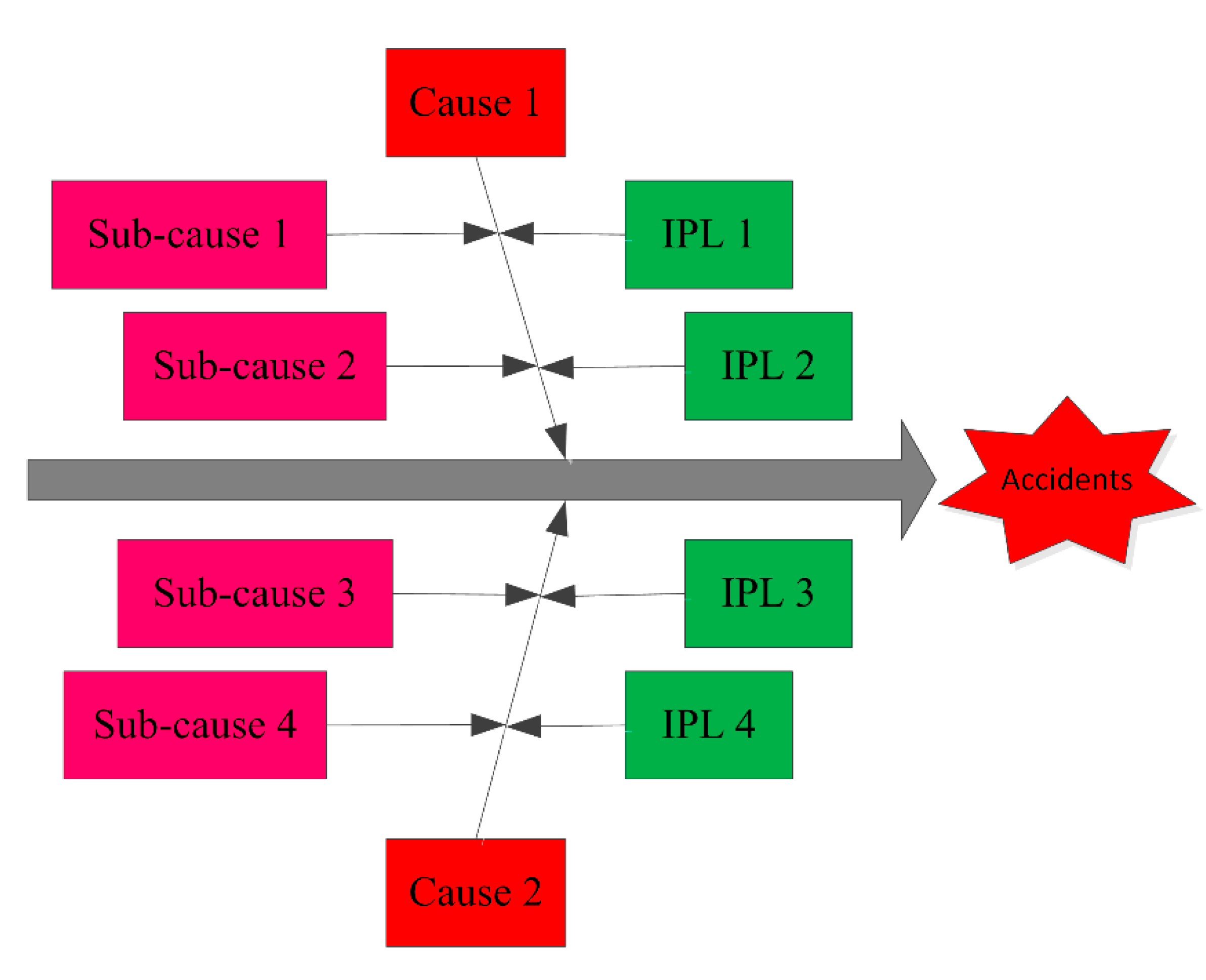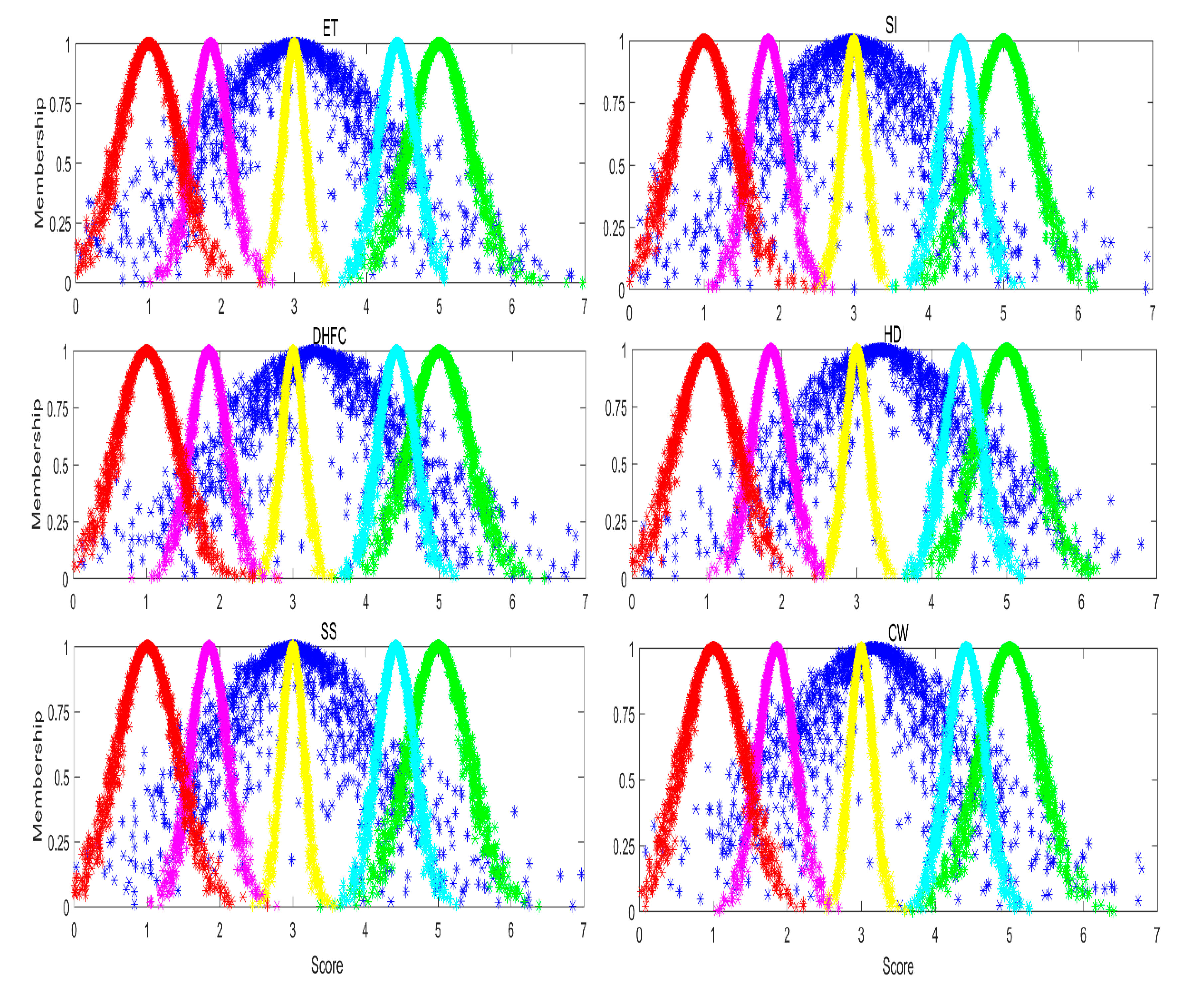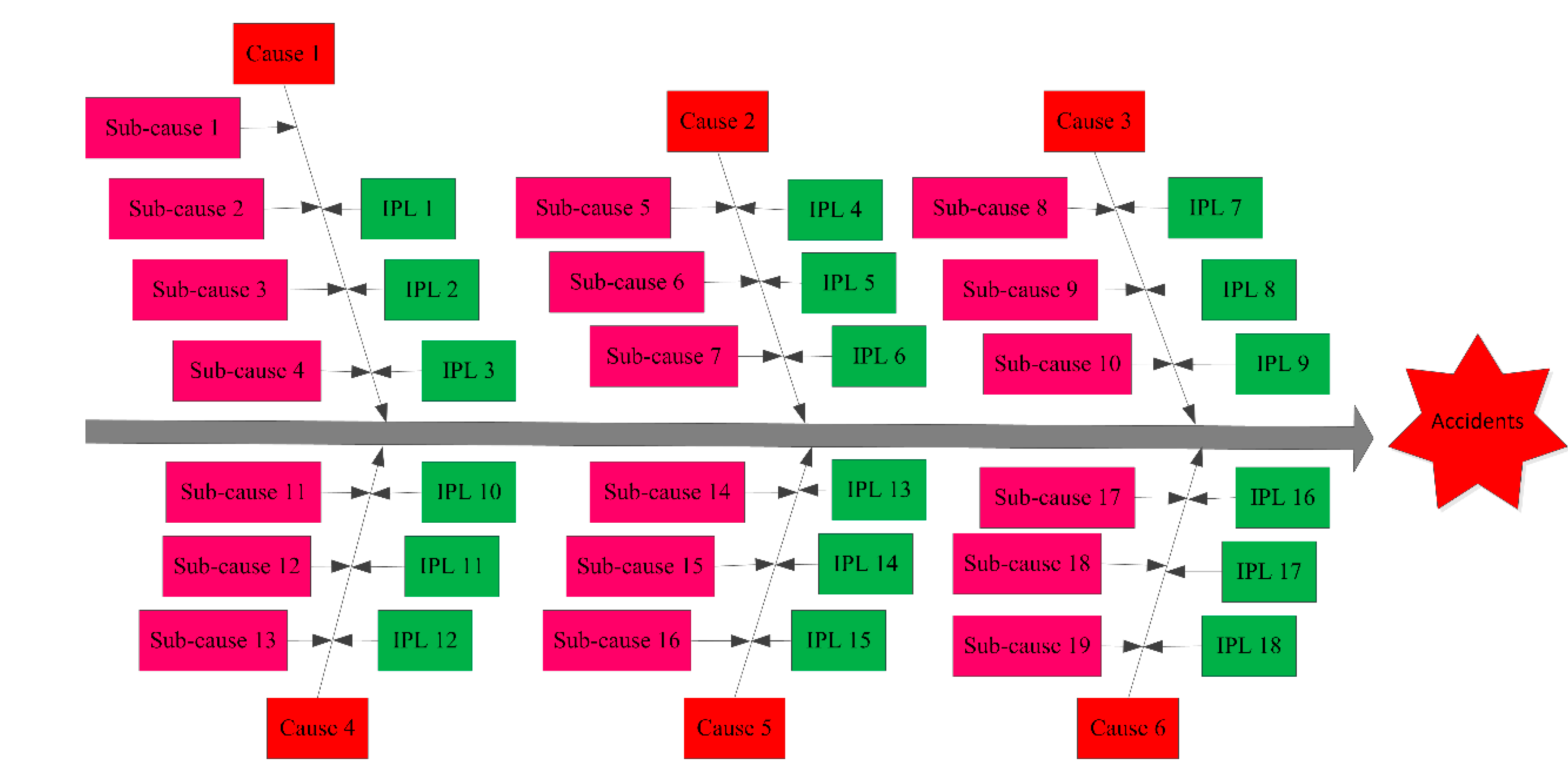Safety Assessment of Casting Workshop by Cloud Model and Cause and Effect–LOPA to Protect Employee Health
Abstract
1. Introduction
2. Methods
2.1. Framework of the Proposed Safety Assessment Method
2.2. Fuzzy Evaluation Method
2.3. Cloud Model
2.3.1. Forward Cloud Algorithm
- (1)
- Generate a normal random number En′ with expectation En and standard deviation He.
- (2)
- Generate a normal random number x with expectation Ex and standard deviation En′.
- (3)
- Calculate
- (4)
- Repeat procedures 1–3 until n cloud drops are created.
2.3.2. Backward Cloud Algorithm
- (1)
- (2)
- (3)
2.3.3. Standard Cloud Model
2.3.4. Comprehensive Cloud Model
2.3.5. Similarity between the Cloud Model and Standard Cloud Model
2.4. Grey Relational Analysis
2.5. Cause and Effect–LOPA
3. Results
3.1. Fuzzy Evaluation of Casting Workshop
3.2. Integrated Weight Determined by Least Square Method
3.3. Cloud Model Evaluation of Sub-indicators
3.4. Cloud Model Evaluation of Casting Workshop
3.5. Comparison by Grey Relational Analysis
3.6. Cause and Effect–LOPA of Dangerous and Harmful Factors
4. Discussion
5. Conclusions
Author Contributions
Funding
Acknowledgments
Conflicts of Interest
References
- Ge, J.; Xu, K.; Zheng, X.; Yao, X.; Xu, Q.; Zhang, B. The main challenges of safety science. Saf. Sci. 2019, 118, 119–125. [Google Scholar] [CrossRef]
- Zhang, J.; Xu, K.; Reniers, G.; You, G. Statistical analysis the characteristics of extraordinarily severe coal mine accidents (ESCMAs) in China from 1950 to 2018. Process Saf. Environ. Prot. 2020, 133, 332–340. [Google Scholar] [CrossRef]
- Ge, J.; Xu, K.; Wu, C.; Xu, Q.; Yao, X.; Li, L.; Xu, X.; Sun, E.; Li, J.; Li, X. What is the object of safety science? Saf. Sci. 2019, 118, 907–914. [Google Scholar] [CrossRef]
- Ji, X.; Ye, H.; Zhou, J.; Yin, Y.; Shen, X. An improved teaching-learning-based optimization algorithm and its application to a combinatorial optimization problem in foundry industry. Appl. Soft Comput. 2017, 57, 504–516. [Google Scholar] [CrossRef]
- Lin, B.; Wu, Y.; Zhang, L. Estimates of the potential for energy conservation in the Chinese steel industry. Energy Policy. 2011, 6, 3680–3689. [Google Scholar] [CrossRef]
- Xu, Q.; Xu, K.; Li, L.; Xu, X.; Yao, X. Energy release and countermeasures for sand casting explosion accidents. Hum. Ecol. Risk Assess. 2019, 26, 1650327. [Google Scholar] [CrossRef]
- Yao, X.; Zhou, H.; Xu, K.; Xu, Q.; Li, L. Investigation on the fusion characterization and melting kinetics of ashes from co-firing of anthracite and pine sawdust. Renew. Energy 2020, 145, 835–846. [Google Scholar] [CrossRef]
- Xu, Q.; Xu, K.; Yao, X.; Li, J.; Li, L. Thermal decomposition characteristics of foundry sand for cast iron in nitrogen atmosphere. R. Soc. Open Sci. 2018, 5, 181091. [Google Scholar] [CrossRef]
- Zhang, B.; Wang, Z.; Yin, J.; Su, L. CO2 emission reduction within Chinese iron & steel industry: Practices, determinants and performance. J. Clean. Prod. 2012, 33, 167–178. [Google Scholar]
- Xu, Q.; Xu, K.; Yao, X.; Zhang, J. Sand casting safety assessment for foundry enterprises: Fault tree analysis, Heinrich accident triangle, HAZOP-LOPA, bow tie model. R. Soc. Open Sci. 2018, 5, 180915. [Google Scholar] [CrossRef]
- Marmo, L.; Piccinini, N.; Fiorentini, L. Missing safety measures led to the jet fire and seven deaths at a steel plant in Turin. Dynamics and lessons learned. J. Loss Prev. Process Ind. 2013, 26, 215–224. [Google Scholar] [CrossRef]
- Li, G.; Ji, T. Severe accidental water vapour explosions in a foundry in China in 2012. J. Loss Prev. Process Ind. 2016, 41, 55–59. [Google Scholar] [CrossRef]
- Fattahi, R.; Khalilzadeh, M. Risk evaluation using a novel hybrid method based on FMEA, extended MULTIMOORA, and AHP methods under fuzzy environment. Saf. Sci. 2018, 102, 290–300. [Google Scholar] [CrossRef]
- Li, J.; Xu, K.; Fan, B.; Geng, L. Risk assessment of oxygen lance burning loss using bow-tie analysis based on fuzzy theory. Math. Probl. Eng. 2020, 2020, 7172184. [Google Scholar] [CrossRef]
- Asakereh, A.; Soleymani, M.; Sheikhdavoodi, M.J. A GIS-based Fuzzy-AHP method for the evaluation of solar farms locations: Case study in Khuzestan province, Iran. Sol. Energy 2017, 155, 342–353. [Google Scholar] [CrossRef]
- Malek, A.; Ebrahimnejad, S.; Tavakkoli-Moghaddam, R. An Improved Hybrid Grey Relational Analysis Approach for Green Resilient Supply Chain Network Assessment. Sustainability 2017, 9, 1433. [Google Scholar] [CrossRef]
- Rapeti, P.; Pasam, V.K.; Rao Gurram, K.M.; Revuru, R.S. Performance evaluation of vegetable oil based nano cutting fluids in machining using grey relational analysis-A step towards sustainable manufacturing. J. Clean. Prod. 2018, 172, 2862–2875. [Google Scholar] [CrossRef]
- Xu, Q.; Xu, K.; Li, L.; Yao, X. Mine safety assessment based on basic event importance: Grey relational analysis and bow tie model. R. Soc. Open Sci. 2018, 5, 180397. [Google Scholar] [CrossRef]
- Polykretis, C.; Chalkias, C. Comparison and evaluation of landslide susceptibility maps obtained from weight of evidence, logistic regression, and artificial neural network models. Nat. Hazards 2018, 93, 249–274. [Google Scholar] [CrossRef]
- Xu, Q.; Xu, K.; Li, L.; Yao, X. Optimization of sand casting performance parameters and missing data prediction. R. Soc. Open Sci. 2019, 6, 181860. [Google Scholar] [CrossRef]
- George, J.; Arun, P.; Muraleedharan, C. Assessment of producer gas composition in air gasification of biomass using artificial neural network model. Int. J. Hydrog. Energy 2018, 43, 9558–9568. [Google Scholar] [CrossRef]
- Xu, Q.; Xu, K. Quality evaluation of Chinese red wine based on cloud model. J. Food Biochem. 2019, 43, e12787. [Google Scholar] [CrossRef] [PubMed]
- Zhang, T.; Yan, L.; Yang, Y. Trust evaluation method for clustered wireless sensor networks based on cloud model. Wirel. Netw. 2016, 24, 777–797. [Google Scholar] [CrossRef]
- Xu, Q.; Xu, K. Evaluation of ambient air quality based on synthetic cloud model. Fresenius Environ. Bull. 2018, 27, 141–146. [Google Scholar]
- Wang, X.; Shi, R.; Lu, Y.; Zhou, Y. Fuzzy comprehensive evaluation of the disaster reduction ability of an ethnic minority accumulation area based on an analytic hierarchy process. Environ. Ecol. Stat. 2019, 26, 239–258. [Google Scholar] [CrossRef]
- Nahayo, L.; Ndayisaba, F.; Karamage, F.; Nsengiyumva, J.B.; Kalisa, E.; Mind’je, R.; Mupenzi, C.; Li, L. Estimating landslides vulnerability in Rwanda using analytic hierarchy process and geographic information system. Integr. Environ. Assess. Manag. 2019, 15, 364–373. [Google Scholar] [CrossRef]
- Chauleur, C.; Gris, J.C.; Laporte, S.; Rancon, F.; Varlet, M.N.; Decousus, H.; Mismetti, P.; Group, S. Use of the Delphi method to facilitate antithrombotics prescription during pregnancy. Thromb Res. 2010, 126, 88–92. [Google Scholar] [CrossRef]
- Dahooie, J.; Zavadskas, E.; Abolhasani, M.; Vanaki, A.; Turskis, Z. A Novel Approach for Evaluation of Projects Using an Interval–Valued Fuzzy Additive Ratio Assessment (ARAS) Method: A Case Study of Oil and Gas Well Drilling Projects. Symmetry 2018, 10, 45. [Google Scholar] [CrossRef]
- Nur Azira, T.; Che Man, Y.B.; Raja Mohd Hafidz, R.N.; Aina, M.A.; Amin, I. Use of principal component analysis for differentiation of gelatine sources based on polypeptide molecular weights. Food Chem. 2014, 151, 286–292. [Google Scholar] [CrossRef]
- Keshavarzifard, M.; Moore, F.; Keshavarzi, B.; Sharifi, R. Distribution, source apportionment and health risk assessment of polycyclic aromatic hydrocarbons (PAHs) in intertidal sediment of Asaluyeh, Persian Gulf. Environ. Geochem. Health 2018, 40, 721–735. [Google Scholar] [CrossRef]
- He, Y.; Guo, H.; Jin, M.; Ren, P. A linguistic entropy weight method and its application in linguistic multi-attribute group decision making. Nonlinear Dyn. 2016, 84, 399–404. [Google Scholar] [CrossRef]
- Sahoo, M.; Sahoo, S.; Dhar, A.; Pradhan, B. Effectiveness evaluation of objective and subjective weighting methods for aquifer vulnerability assessment in urban context. J. Hydrol. 2016, 541, 1303–1315. [Google Scholar] [CrossRef]
- Xu, Q.; Xu, K. Mine safety assessment using gray relational analysis and bow tie model. PLoS ONE 2018, 13, e0193576. [Google Scholar] [CrossRef]
- Opait, G.; Bleoju, G.; Nistor, R.; Capatina, A. The influences of competitive intelligence budgets on informational energy dynamics. J. Bus. Res. 2016, 69, 1682–1689. [Google Scholar] [CrossRef]
- Jie, P.; Zhang, F.; Fang, Z.; Wang, H.; Zhao, Y. Optimizing the insulation thickness of walls and roofs of existing buildings based on primary energy consumption, global cost and pollutant emissions. Energy 2018, 159, 1132–1147. [Google Scholar] [CrossRef]
- Pulivarti, S.R.; Birru, A.K. Optimization of green sand mould system using Taguchi based grey relational analysis. China Foundry 2018, 15, 152–159. [Google Scholar] [CrossRef]
- Arvanitoyannis, I.S.; Varzakas, T.H. A conjoint study of quantitative and semi-quantitative assessment of failure in a strudel manufacturing plant by means of FMEA and HACCP, Cause and Effect and Pareto diagram. Int. J. Food Sci. Technol. 2017, 42, 1156–1176. [Google Scholar] [CrossRef]
- Yan, F.; Xu, K. A set pair analysis based layer of protection analysis and its application in quantitative risk assessment. J. Loss Prevent. Proc. 2018, 55, 313–319. [Google Scholar] [CrossRef]
- Hollnagel, E. Risk + barriers = safety? Saf. Sci. 2008, 46, 221–229. [Google Scholar] [CrossRef]
- Kjellén, U. Prevention of Accidents through Experience Feedback; CRC Press: New York, NY, USA, 2000. [Google Scholar]
- Liu, Y.; Huang, X.; Duan, J.; Zhang, H. The assessment of traffic accident risk based on grey relational analysis and fuzzy comprehensive evaluation method. Nat. Hazards 2017, 88, 1409–1422. [Google Scholar] [CrossRef]
- Zang, W.; Ren, L.; Zhang, W.; Liu, X. A cloud model based DNA genetic algorithm for numerical optimization problems. Future Gener. Comput. Syst. 2018, 81, 465–477. [Google Scholar] [CrossRef]
- Deng, S. Production Accident in Casting Workshop of a Machine Building Enterprise in Hunan Province Statistical Analysis and Safety Evaluation. Master’s Thesis, Hunan University of Science and Technology, Xiangtan, China, 2017; pp. 54–55, (In Chinese with English abstract). [Google Scholar]
- Ma, Z.; Song, J.; Zhang, J. Energy consumption prediction of air-conditioning systems in buildings by selecting similar days based on combined weights. Energy Build. 2017, 151, 157–166. [Google Scholar] [CrossRef]
- Xu, Q.; Xu, K. Assessment of air quality using a cloud model method. R. Soc. Open Sci. 2018, 5, 171580. [Google Scholar] [CrossRef] [PubMed]
- Xu, Q.; Xu, K. Risk assessment of rail haulage accidents in inclined tunnels with Bayesian network and bow-tie model. Curr. Sci. 2018, 114, 2530–2538. [Google Scholar] [CrossRef]
- Babaei, M.; Roozbahani, A.; Shahdany, S.M.H. Risk Assessment of Agricultural Water Conveyance and Delivery Systems by Fuzzy Fault Tree Analysis Method. Water Resour. Manage. 2018, 32, 4079–4101. [Google Scholar] [CrossRef]




| Evaluation Indicator | ET | SI | DHFC | HDI | SS |
|---|---|---|---|---|---|
| ET | 1 | 1/2 | 1/2 | 1/2 | 2 |
| SI | 2 | 1 | 2 | 1/2 | 2 |
| DHFC | 2 | 1/2 | 1 | 1/2 | 2 |
| HDI | 2 | 2 | 2 | 1 | 2 |
| SS | 1/2 | 1/2 | 1/2 | 1/2 | 1 |
| Level | Score | Standard Cloud Model |
|---|---|---|
| Safe | 5 | C1(5,0.413,0.042) |
| Relatively safe | 4 | C2(4.146,0.255,0.026) |
| Generally safe | 3 | C3(3,0.158,0.016) |
| Relatively dangerous | 2 | C4(1.854,0.255,0.026) |
| Dangerous | 1 | C5(1,0.413,0.042) |
| Indicator | Cloud Model |
|---|---|
| ET | (2.998,1.1085,0.364) |
| SI | (2.978,1.0007,0.4186) |
| DHFC | (3.302,1.0835,0.3745) |
| HDI | (3.321,1.1041,0.3661) |
| SS | (2.994,1.0603,0.3702) |
| CW | (3.1592,1.0711,0.3793) |
| Indicator | Similarity | ||||
|---|---|---|---|---|---|
| λ1 | λ2 | λ3 | λ4 | λ5 | |
| ET | 0 | 0.00004 | 0.99992 | 0.00004 | 0 |
| SI | 0 | 0.00003 | 0.99035 | 0.00006 | 0.00001 |
| DHFC | 0.00021 | 0.00418 | 0.16097 | 0 | 0 |
| HDI | 0.00026 | 0.00534 | 0.127 | 0 | 0 |
| SS | 0 | 0.00004 | 0.99928 | 0.00005 | 0 |
| CW | 0.00005 | 0.00056 | 0.60196 | 0 | 0 |
| Cause | Description | Cause | Description |
|---|---|---|---|
| Cause 1 | Dust | Sub-cause 8 | Alloy melting and casting |
| Cause 2 | Noise | Sub-cause 9 | Welding operation |
| Cause 3 | Toxic gas | Sub-cause 10 | Swabbing |
| Cause 4 | Mechanical injury | Sub-cause 11 | Unsafe condition of equipment |
| Cause 5 | Empyrosis | Sub-cause 12 | Unsafe behavior of human |
| Cause 6 | Electric shock | Sub-cause 13 | Safe distance is not sufficient |
| Sub-cause 1 | Sand mixing | Sub-cause 14 | Molten metal spatter |
| Sub-cause 2 | Modelling | Sub-cause 15 | Contact with high temperature smelter |
| Sub-cause 3 | Shakeout | Sub-cause 16 | Contact with uncooled casting and core |
| Sub-cause 4 | Fettling | Sub-cause 17 | Electrical equipment is defective |
| Sub-cause 5 | Shakeout finishing | Sub-cause 18 | Insulated wire aging |
| Sub-cause 6 | Vibration modelling | Sub-cause 19 | Safe voltage not used |
| Sub-cause 7 | Air blower working |
| IPL | Description | IPL | Description |
|---|---|---|---|
| IPL 1 | Wearing a mask | IPL 10 | Rationally plan equipment installation location |
| IPL 2 | Wet working | IPL 11 | Isolating work areas and non-work areas with barriers |
| IPL 3 | Dust removal by ventilation | IPL 12 | Employees must abide by operating regulation |
| IPL 4 | Wearing earplugs | IPL 13 | Wearing high temperature protective equipment |
| IPL 5 | Set up sound proof wall | IPL 14 | Isolation of high temperature work area |
| IPL 6 | Equipment with shock absorber | IPL 15 | Alert when transporting molten metal |
| IPL 7 | Strengthening ventilation | IPL 16 | Design of electrical equipment to meet safety criterion |
| IPL 8 | Using environment friendly coating | IPL 17 | Establish and improve the operating guidelines for electrical equipment |
| IPL 9 | Install air cleaning unit | IPL 18 | Set a warning mark |
© 2020 by the authors. Licensee MDPI, Basel, Switzerland. This article is an open access article distributed under the terms and conditions of the Creative Commons Attribution (CC BY) license (http://creativecommons.org/licenses/by/4.0/).
Share and Cite
Xu, Q.; Xu, K.; Zhou, F. Safety Assessment of Casting Workshop by Cloud Model and Cause and Effect–LOPA to Protect Employee Health. Int. J. Environ. Res. Public Health 2020, 17, 2555. https://doi.org/10.3390/ijerph17072555
Xu Q, Xu K, Zhou F. Safety Assessment of Casting Workshop by Cloud Model and Cause and Effect–LOPA to Protect Employee Health. International Journal of Environmental Research and Public Health. 2020; 17(7):2555. https://doi.org/10.3390/ijerph17072555
Chicago/Turabian StyleXu, Qingwei, Kaili Xu, and Fang Zhou. 2020. "Safety Assessment of Casting Workshop by Cloud Model and Cause and Effect–LOPA to Protect Employee Health" International Journal of Environmental Research and Public Health 17, no. 7: 2555. https://doi.org/10.3390/ijerph17072555
APA StyleXu, Q., Xu, K., & Zhou, F. (2020). Safety Assessment of Casting Workshop by Cloud Model and Cause and Effect–LOPA to Protect Employee Health. International Journal of Environmental Research and Public Health, 17(7), 2555. https://doi.org/10.3390/ijerph17072555






